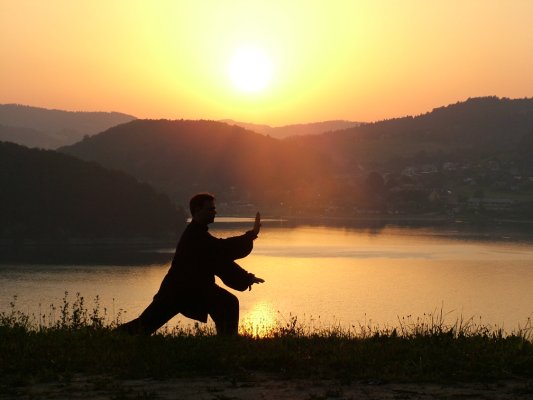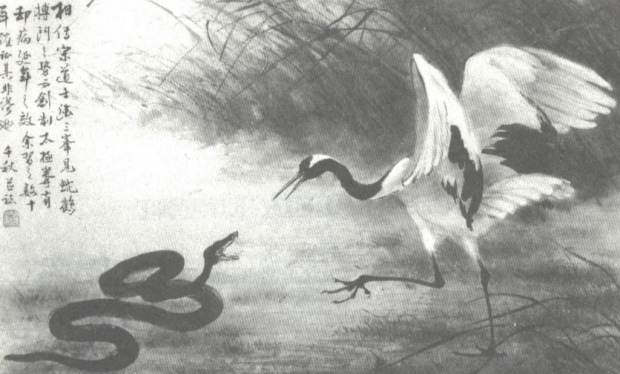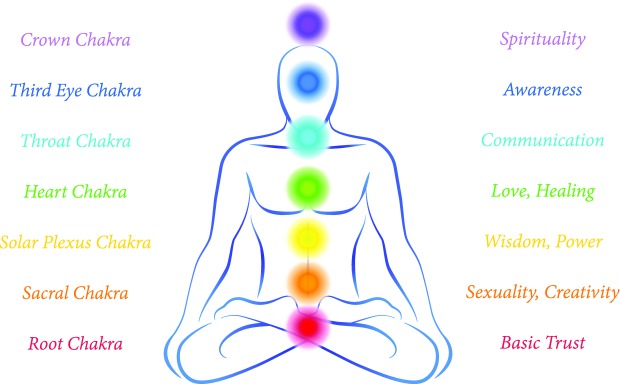
Recently I attended a free introduction to Tai Chi session in The Dublin Holistic Centre . I was recommended by a friend to try it out as it was “calming” and “right up my street”.I YouTubed it and instantly I was attracted to it. Like minded people, standing in a small group, slow moving, in a deep relaxed state. I HAD TO TRY IT!
So what is Tai Chi?
Tai Chi is known as a mind art which combats stress, tiredness, sadness, anxiety and addictions. It focuses on posture, breathing, awareness and powerful whole body movements. It’s basically an internal Chinese martial art that is practiced for both defense training and its health benefits. You may have seen it in movies such as Jackie Chan or the Karate Kid. It is comprised of 37-postures, or movement patterns, which are repeated to the left or right to create the 108-movement sequence.
Supposedly, it came about when a crane (a type of bird) and a snake came into contact with each other. The snake 🐍 attempted to attack the crane. The crane remained still and gently moved away from each attack the snake made. Eventually the crane wore the snake out and he was able to kill the snake. The aim of Tai Chi is to become the crane.

So off I went at the crack of dawn, one cold Wednesday morning, to see how I could become a Crane. Beforehand I had pictured myself in slow-mo dancing around a room with old men in white clothing and long white beards becoming at Awe with the universe. When I arrived, I was greeted by a very pleasant man man dressed in navy and no beard. He explained the benefits of Tai Chi and what exactly the introductory class would entail. There were four people in attendance. The room was smallish but cozy and appropriate for its use.
We started off by doing some meditation exercises to relax our minds and bodies. This included slow hand movements and breathing exercises with our eyes closed. Once we had all become grounded and calm, we began the Tai Chi exercises.The more relaxed your body and mind are, the more abundantly your energy can circulate. This is the first stage, known as Regulating the Body. Eventually, if you are interested in following the traditional path, you can progress through the stages of Regulating the Breath, the Mind, the Qi (the energy), and the Spirit. It can take up to three years to achieve full energy enhancements and full health benefits (a very long time).
I was informed that it would take around 6 weeks to learn one movement but today he would explain a few different movements to give me a taster. SIX WEEKS TO LEARN ONE MOVEMENT. The thoughts of this was off putting. We started off with slow arm movements and different movements to shift our energies. He played relaxation music in the background which is fav! Eventually after 1 hour and 30 minutes, we had completed one complete move. One move contained several different movements. Each of these movements would take up to 6 weeks to conquer. Good posture is the main component of Tai Chi. If you are aware of the 7 Chakras (the wheels of energies in our bodies), you will know how important it is to have your spine straight and in line with your pelvis and head. Energies are transferred (Qigong – energy work) from the Crown Chakra (crown of your head) to the Root Chakra (base of your spine).
I will dedicate a future post to Chakra’s alone but in the meantime here is a brief overview of what each Chakra represents, its location and the emotional issues they bring about:
1. Root Chakra — Represents our foundation and feeling of being grounded.
- Location: Base of spine in tailbone area.
- Emotional issues: Survival issues such as financial independence, money and food.
2. Sacral Chakra — Our connection and ability to accept others and new experiences.
- Location: Lower abdomen, about two inches below the navel and two inches in.
- Emotional issues: Sense of abundance, well-being, pleasure and sexuality.
3. Solar Plexus Chakra — Our ability to be confident and in control of our lives.
- Location: Upper abdomen in the stomach area.
- Emotional issues: Self-worth, self-confidence and self-esteem.
4. Heart Chakra — Our ability to love.
- Location: Center of chest just above the heart.
- Emotional issues: Love, joy and inner peace.
5. Throat Chakra — Our ability to communicate.
- Location: Throat.
- Emotional issues: Communication, self-expression of feelings and the truth.
6. Third Eye Chakra — Our ability to focus on and see the big picture.
- Location: Forehead between the eyes (also called the Brow Chakra).
- Emotional issues: Intuition, imagination, wisdom and the ability to think and make decisions.
7. Crown Chakra — The highest chakra represents our ability to be fully connected spiritually.
- Location: The very top of the head.
- Emotional issues: Inner and outer beauty, our connection to spirituality and pure bliss


Tai Chi is all about the movement of energies in order to remove negative energy and increase positive energies. This energy in our bodies is derived from the food we eat and the fat we burn, combined with the air we breathe through the metabolic process. In addition, with every breath you are inhaling air, which is a gas, which is made of molecules, which are made of atoms, which are made of energy. You inhale positive or negative ions all day long. We also receive some percentage of our body’s energy from the sun and moon, and our body’s energy is influenced by the radiation of our surroundings, both natural and manmade. In fact, the human body is a living bioelectromagnetic field.
The next bit I have just copied and pasted off a website that explained how energies move within our bodies. I tried to rewrite it in my own words but I found it very difficult to explain.
When you want to move your body, your mind generates an electrical impulse through the spine to the muscles, and suddenly you are Grasping the Sparrow’s Tail. Your intention to move first creates a brainwave – this is an electrical frequency usually between 1 – 20Hz. The impulse then transmits instantaneously throughout the body in a complex process that utilizes your body’s energy to facilitate movement. A typical modern way of measuring your energy is with an EEG (Electroencephalogram), which distinguishes brainwaves by measuring the speed with which neurons (nerve cells) fire in cycles per second. Alpha brain waves range between 7 – 12 Hz, which relates to deep relaxation. The Alpha range is also the base frequency of the Schumann Resonance, which is the vibrational frequency of the earth’s electromagnetic field. When you are deeply relaxed, your Alpha brainwaves resonate in sympathy with the earth’s EMF, producing “constructive interference” which amplifies the vibration.


Whether you view the body’s energetic activity from a chemical, spiritual, or purely mechanical viewpoint, understand that this energy within the body is the Qi we are referring to; Qi is not some special “other” kind of energy. This subject has been widely misunderstood, sometimes because of the limited understanding by students of these concepts since Tai Chi came to the West, and largely due to cultural and language barriers.
Don’t keep searching for your energy when you practice. Realize that you are energy.
You are not a human body experiencing a spirit. You are a spirit experiencing a human body.
Thus, when you understand a Tai Chi posture clearly, your will mind generate the correct intention, and you will energize your body all the way to the fingers and toes more efficiently. This will gradually improve your circulation to the extremities, and help to permeate your body with healthy circulation of blood, energy, and nutrients.
The class ended with a guided meditation exercise following with a closing of our energies. We basically inhaled positive energy and moved it into our bodies with arm movements then we closed ourselves up again.
Tai Chi Tips
- Practice out in nature and get some fresh air, preferably near mountains, forests, or water for an increase of negative ions.
- Close your mouth loosely, and touch the tongue to the roof of the mouth gently.
- Breathe naturally. Don’t worry about your breathing until later in your practice.
- Tai Chi is whole body exercise. Movement is initiated in the legs, directed by the waist, and manifested in the hands.
- Upper body is light, the middle body is flexible, and the lower body is solid and heavy.
- Energy follows consciousness, or as its put in qigong study, “The Yi Leads the Qi.”
- Stay relaxed and don’t frown from concentrating too hard. Tai Chi is fun!
Overall thoughts:
I found Tai Chi was not for me. It was waaaaay too slow. I love meditation and yoga but this was completely different all together. Maybe I need to slow myself down a bit more? Maybe I should not have went before college as I had a lot on my mind that day? Small groups do sometimes make me a bit anxious. I had to repeat some postures a few times as I was not doing them correctly so this also put me off. Another thing may have been that I attended with my friend. BIG MISTAKE. Awkward silences led to me and him looking at each other and giggling. He would stand in front of me and we would have to move at the same pace with our eyes closed by bonding our energies together without looking. I opened my eyes a few times and seen him doing the postures and found it hilarious. We would glance at each other the odd time both thinking ‘WTF are we doing here?’. Overall I don’t think I will be going back. Yoga and light meditation is as far as my inner ZEN will be going.
J x













